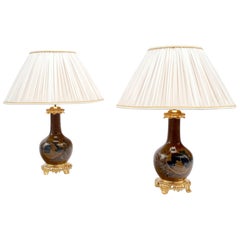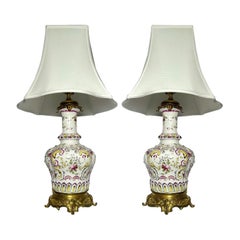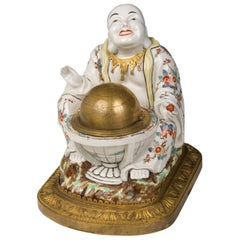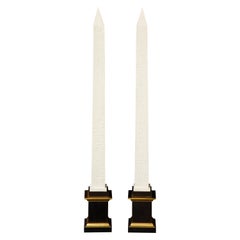Bronze Porcelain
to
16
129
8
4
109
16
8
10
2
3
3
1
1
1
1
23
7
5
4
3
2
2
2
7,335
7,118
507
201
137
75
56
118
95
9
9
7
137
129
130
25
7
3
3
2
Material: Bronze
Pair of Brown and Blue Porcelain Lamps, Japanese Style, Late 19th Century
Located in Saint-Ouen, FR
Pair of baluster shape brown and blue porcelain lamps. Decoration of Japanese style figures in a cartouche framed with vegetals and flowers with deep blue and gold highlights.
Mounte...
Category
Late 19th Century Japonisme Antique Bronze Porcelain
Materials
Bronze
Antique French Porcelain and Gold Bronze Mounted Lamps, circa 1890.
Located in New Orleans, LA
Antique French Porcelain and Gold Bronze Mounted Lamps, Circa 1890.
Category
19th Century French Antique Bronze Porcelain
Materials
Bronze
French Porcelaine and Bronze Inkstand, Marks of Samson, 19th Century
Located in Saint-Ouen, FR
French Porcelaine and bronze inkstand. Marks of Samson, 19th century.
Category
19th Century French Antique Bronze Porcelain
Materials
Bronze
Pair of Celadon Porcelain Lamps with Persian Style Flowers, Late 19th Century
Located in Saint-Ouen, FR
Pair of celadon porcelain lamps with on a gilt bronze mounting. Decoration of stylized vegetal frieze in the Persian taste.
Refurbished electric system.
Work realized at the end of the 19th century.
! The price doesn’t include the lampshade price. However, our workshop can advise you with pleasure and realize it with your size and color choices !
Celadon designates both a color and a type of ceramic specific to China and the Far East. "Celadon Green": it's a color name designating a shade of green. Celadon is particularly appreciated in Asia, because it allows to obtain the color of jade, the sacred stone. The name celadon is today almost always associated with porcelain, usually Chinese. In French, the origin of the word comes from Honoré d...
Category
Late 19th Century Antique Bronze Porcelain
Materials
Bronze
Sèvres Porcelain 'Jeweled' Three-Piece Clock Set by Raingo Frères
Located in Long Island City, NY
A wonderful and important mid-19th century gilt bronze and turquoise sevres porcelain 'Jeweled' three-piece clock set.
By Raingo Frères.
...
Category
Mid-19th Century French Belle Époque Antique Bronze Porcelain
Materials
Bronze
Pr. Signed Sevres Porcelain, Patinated and Gilt Bronze Mounted Egyptian Obelisks
Located in New York, NY
A fabulous and quite unusual pair of original signed and marked Sevres Porcelain patinated and gilt bronze mounted Egyptian Inspired Hyroglifics biscuit Porcelain obelisks. These are...
Category
1920s French Mid-Century Modern Vintage Bronze Porcelain
Materials
Bronze
Fantastic Late 19th Century Gilt Bronze Mounted Onyx and Sèvres Style Pedestal
Located in Long Island City, NY
A Rare and Fantastic Late 19th Century Gilt Bronze Mounted Onyx and Sèvres Style Pedestal
Square onyx top above a columnar support painted with...
Category
Late 19th Century French Belle Époque Antique Bronze Porcelain
Materials
Onyx, Bronze, Ormolu
19th Century Dore Bronze and Sèvres Porcelain Mounted Parquetry Cabinet
By Manufacture Nationale de Sèvres, Adam Weisweiler
Located in New York, NY
A Marvelous Quality Louis XVI Style Dore Bronze and Sèvres Porcelain Mounted Parquetry Cabinet with a Hand-Carved Marble Top. The large centra...
Category
1880s French Belle Époque Antique Bronze Porcelain
Materials
Marble, Bronze
Covered Urns 'attributed to Sevres'
Located in Bronx, NY
This vintage pair of stunning porcelain covered urns date from the mid 19th century & are attributed to Sevres. Each urn is beautifully decorated with cha...
Category
Mid-19th Century French Romantic Antique Bronze Porcelain
Materials
Bronze
$5,500 / set
Louis XVI Style Mantel Clock by Ernest Royer
Located in London, GB
This fine neoclassical style mantel clock will make a sumptuous addition to a grand room, or could be given as a unique gift to a loved one. The clock is the work of Ernest Royer, an...
Category
19th Century French Louis XVI Antique Bronze Porcelain
Materials
Bronze, Ormolu
Ormolu-Mounted Porcelain Horses by Samson Manufactory
By Samson & Cie
Located in Paris, FR
Pair of 20th century white porcelain horses on clouds, above rocaille bases richly decorated with scrollwork and openwork foliage. Both figures are marked underneath with two crossed...
Category
Early 20th Century French Louis XV Bronze Porcelain
Materials
Ormolu, Bronze
Sèvres-Style Porcelain Pedestal
Located in New Orleans, LA
This pedestal exhibits the style and grace of the famed Sèvres porcelain manufactory. Its lustrous deep blue porcelain base is Classic Sèvres in style, and it provides the perfect ba...
Category
Late 19th Century French Neoclassical Antique Bronze Porcelain
Materials
Bronze
Bejewelled 19th Century Sevres Style Clock Set
Located in London, GB
A fine quality 19th century French Sevres porcelain style and gilded ormolu clock garniture, impressive pair of four branch candelabra.
Measures: Clock, H: 53cm, D: 24cm, W: 27cm...
Category
Late 19th Century French Antique Bronze Porcelain
Materials
Bronze
Nice Late 19th Century Gilt Bronze and Champlevé Enamel Sèvres Style Centerpiece
Located in Long Island City, NY
A nice late 19th century gilt bronze and champlevé enamel mounted Sèvres style centerpiece
The porcelain plate decorated with a scene of an...
Category
Late 19th Century French Belle Époque Antique Bronze Porcelain
Materials
Bronze, Enamel
Samson Porcelaine Center Mounted in Louis XV Style Bronze
Located in Saint-Ouen, FR
Samson Porcelaine center
mounted in Louis XV style bronze
Late 19th century
Decorated with country scenes.
Category
Late 19th Century French Antique Bronze Porcelain
Materials
Bronze
Japanese 19th Century Lacquer Over Porcelain Compote
Located in Dallas, TX
Antique Japanese red and black lacquer over porcelain compote. With French bronze doré acorn finial, pedestal, trim and handles. Circa 1890.
Category
1890s Japanese Antique Bronze Porcelain
Materials
Bronze
Important Empire Period Paris Porcelain & Ormolu-Mounted Casket/Box/Jewelry Box
Located in New York, NY
An Important and very rare Empire period Paris porcelain ormolu-mounted Empire rectangular shaped two-handled casket decorated and assembled by ...
Category
1810s French Empire Antique Bronze Porcelain
Materials
Bronze
Recently Viewed
View AllMore Ways To Browse
Kakiemon Plate
Magnolia Plate
Meissen 18
Haviland Porcelain Hand Painted Plates
Minton Cobalt Blue
Imperial Service Plates
Japanese Dinnerware
Meissen Coffee Cup
Meissen Fruit
Meissen Gardeners Children
Imprisoned Glass
Limoges Cobalt Blue With Gold
Meissen Cabinet
Meissen Capture
Meissen Coffee Cup And Saucer
German Christmas Angel
Hermes Cup
Meissen Putti





